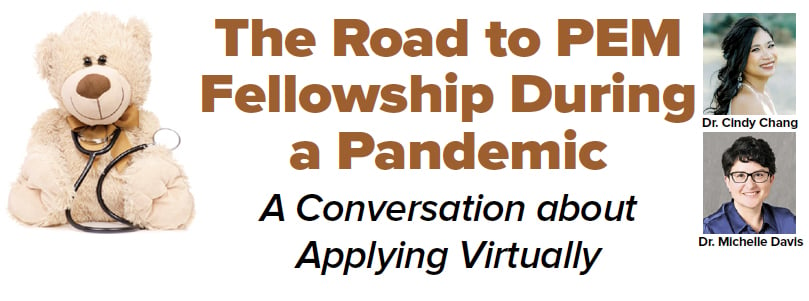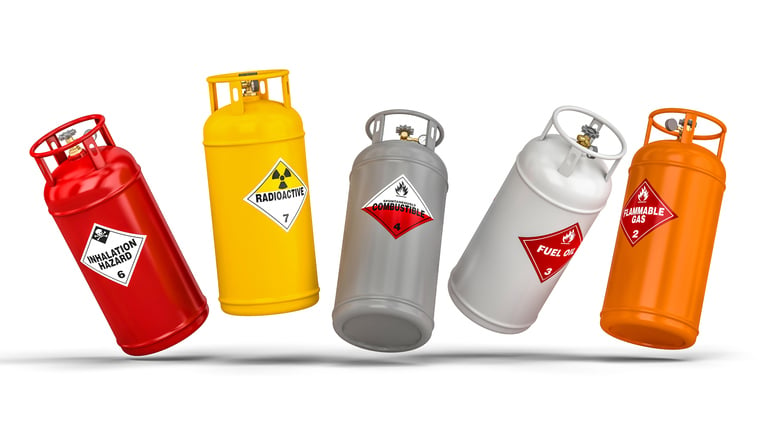Consensus Statement on the 2020-2021 Residency Application Process for US Medical Students Planning Careers in Emergency Medicine in the Main Residency Match*

The COVID-19 pandemic has disrupted clinical education in all U.S. medical schools, and has created unique challenges for the field of Emergency Medicine (EM). As Emergency Departments are primary sites for COVID-related care, the capacity of teaching hospitals to provide safe and appropriate EM experiences for students has been severely limited. Public health considerations have led to travel restrictions, which reduce the ability of students to complete away rotations, and necessitate major changes in the residency application process.
The Coalition on Physician Accountability (CoPA) recently issued a statement regarding COVID-related issues faced by the medical school class of 2021.1 We affirm our agreement with the CoPA guidelines, and offer advice on how to operationalize these within EM. In developing our recommendations, safety and equity were the guiding principles. The health of students, educators, patients, and the public is our top priority, and we do not feel that students should place themselves or their communities at risk through unnecessary exposures. We also feel strongly that the residency application process should be as equitable as possible, and aim to offer all students the best possible opportunity to succeed in their career aspirations. Therefore, we offer the following guidelines:
- EM rotations: Ideally, each student will complete one and only one EM rotation, typically at their home institution. Students with access to home EM rotations should not seek away rotations. Some institutions have the good fortune of being able to offer more than one home rotation to EM-bound students. Whenever possible, we strongly urge institutions to use this surplus capacity to provide rotation opportunities for students who lack access to EM at their own institutions.
- Standardized Letters of Evaluation (SLOEs): Each student is expected to have only one EM clerkship SLOE in their residency application portfolio, typically an institutional SLOE from the site of their single EM rotation. Institutional SLOEs should be authored by rotation directors with input from other education leaders, and should reflect robust departmental input regarding all aspects of student performance. Because this SLOE will have significant weight, SLOE writers are encouraged to write a balanced review of students and avoid overbias to the positive. Obtaining multiple SLOEs from a single rotation is discouraged. Residency program directors should expect only one SLOE for each student and consider applications with a single SLOE as complete. While more than one SLOE is discouraged, it is possible that due to extraordinary circumstances, some students may have access to multiple EM rotations and thus multiple SLOEs. We emphasize that program directors should not view these
students more favorably than those with only a single SLOE. - Non-EM SLOE Letters of Recommendation: As most students will only have a single SLOE, it will be necessary for residency programs to place greater emphasis on non-EM SLOE letters. These may be obtained from non-EM rotations, subspecialty EM experiences (e.g., ultrasound, toxicology, etc.), or from EM mentors with whom the applicant has a particular relationship. To support students and program directors, the Council of Residency Directors in EM (CORD) and Clerkship Directors in EM (CDEM) have convened a committee to provide a format and instructions for non-EM SLOE letters written on behalf of EM applicants. We strongly encourage programs to use these non-EM SLOEs to help evaluate candidates’ non-cognitive skills and clinical skills in non-EM rotations. We strongly recommend that EM programs disseminate information regarding these non-EM SLOE letters to students and non-EM faculty. We encourage students to request non-EM SLOE formatted letters from their letter writers.
- EM residency interviews: All EM residency interviews should be conducted virtually in the 2020-21 application year. In-person interviews should not be offered to any applicants, including those deemed to be local. “Second look” visits should not be expected or required of any applicant. While second looks are well intentioned, they have the potential to cause students to feel pressured; they should only be offered if able to be conducted safely and without creating a sense of obligation on the
part of the student. Residency programs should not evaluate students who make second look visits differently from those who do not. - Interview numbers: Students should ideally interview at 12 EM residency programs, with an absolute maximum of 17. Historical data clearly demonstrate that greater than 95% of EM applicants (allopathic, osteopathic, and international medical graduates) who interview at 12 programs will match.2,3,4,5 However, some leeway is needed to accommodate students participating in the couples match and those who are at particularly high risk of not matching. Students who are offered extra interview invitations should decline interviews at programs that are lower on their preference lists to make these interview slots available to other students. There are a finite number of interview positions. When students who have prioritized other programs occupy these slots, this disadvantages these programs as well as their peers, contributing to peers not matching and/or programs not filling.
- General considerations:
Students:
- Students should be particularly mindful when preparing all parts of the residency application, as there will be increased emphasis on parts of the application that are traditionally less important.
- Not being able to visit residency programs, students should carefully research programs in order to make informed choices when compiling their match lists.
- Having reduced exposure to clinical training in EM, students should seek out supplementary learning opportunities to enhance their preparedness for residency.
Medical student educators:
- Students are likely to have considerable anxiety during this unprecedented time, and educators may need to provide additional advising and support.
- Students will have fewer EM experiences, which may lead to uncertainty regarding specialty choice. Educators can mitigate this by organizing career exploration sessions to ensure that students are as informed as possible about what to expect in residency and beyond.
- With limited access to rotations, students will also have less clinical preparation for EM residency than is usual. They may benefit from additional EM-related learning and practice opportunities, particularly late in the fourth year of medical school when they are preparing to transition to the intern role.
- When writing SLOEs, educators should present students as honestly and completely as possible. Ratings should reflect the student’s true abilities relative to their peers, and comments should address both strengths and areas of ongoing growth.
- Students at institutions lacking EM experiences will be in dire need of advising and support. Educators are encouraged to “adopt” these students when possible, and to advocate for their access to EM rotations and advising.
Residency program leaders:
- Students will have less knowledge of the residency programs to which they apply, which may lead to dissatisfaction. Programs can mitigate this by creating robust virtual experiences for applicants that allow them to explore residency curriculum and culture.
- Programs will be asked to select applicants with less information than is usual or desirable, and will have to make significant modifications to their selection processes. We encourage programs to view applications holistically, taking into consideration the entire picture of the student’s academic potential rather than focusing on only one or two key metrics.
- Programs may need to expand the recruitment faculty team in order to holistically review applications, training these reviewers and interviewers to recognize and overcome individual implicit bias and develop a standardized approach to their review.
- Truncated clinical experiences may result in students transitioning to internship with suboptimal confidence and competence. Programs should plan for enhanced intern orientation programs to compensate for this.
- Programs are encouraged to have clear communication on their website about the values they seek in applicants, culture of the program, and the timeline in which they expect to offer interviews and for how long they expect to interview.
While challenges lie ahead, this is sure to be an excellent residency application cycle, just as it’s always been. As teamwork is the core of our specialty, we will all get through this together. We are emergency medicine.
David A. Farcy, MD, FAAEM, FCCM
President
American Academy of Emergency Medicine (AAEM)
Haig Aintablian, MD, MSc
President
AAEM-Resident and Student Association (RSA)
Robert E. Suter, DO, MHA, FACOEP-D
President
American College of Osteopathic Emergency Physicians (ACOEP)
Christina Hornack, DO
President
ACOEP-Resident Student Organization (RSO)
William Jaquis, MD, FACEP
President
American College of Emergency Physicians (ACEP)
Julianna Jung, MD, MEd
President
Clerkship Directors in Emergency Medicine (CDEM)
Fiona Gallahue, MD
President
Council of Residency Directors in Emergency Medicine (CORD)
Hannah Hughes, MD, MBA
President
Emergency Medicine Residents’ Association (EMRA)
James F. Holmes, Jr., MD, MPH
President
Society for Academic Emergency Medicine (SAEM)
Andrew B. Starnes, MD, MPH
President
SAEM Residents and Medical Students (RAMS)
*These guidelines apply to the Main Residency Match and do not apply to students who have a contractual obligation to the military or are applying to the military match.
1 The Coalition for Physician Accountability’s Work Group on Medical Students in the Class of 2021 Moving Across Institutions for Post Graduate Training. (2020). Final Report and Recommendations for Medical Education Institutions of LCME-Accredited, U.S. Osteopathic, and Non-U.S. Medical School Applicants. Retrieved from https://www.aamc.org/system/files/202005/covid19_Final_Recommendations_05112020.pdf
2 National Residency Match Program. (2020). Impact of Length of Rank Order List on Match Results: 2002-2020 Main Residency Match. Retrieved from https://mk0nrmp3oyqui6wqfm.kinstacdn.com/wp-content/uploads/2020/05/Impact-Data_All_Sponsored-Apps_2020.pdf
3 National Resident Matching Program. (2018). Charting Outcomes in the Match: U.S. Allopathic Seniors (2nd ed.). Retrieved from https://mk0nrmp3oyqui6wqfm.kinstacdn.com/wp-content/uploads/2019/10/Charting-Outcomes-in-the-Match-2018_Seniors-1.pdf
4 National Resident Matching Program. (2018). Charting Outcomes in the Match: Senior Students of U.S. Osteopathic Medical Schools (1st Edition). Retrieved from https://mk0nrmp3oyqui6wqfm.kinstacdn.com/wp-content/uploads/2018/06/Charting-Outcomes-in-the-Match-2018-Osteo.pdf
5 National Resident Matching Program. (2018). Charting Outcomes in the Match: International Medical Graduates (2nd Edition). Retrieved from https://mk0nrmp3oyqui6wqfm.kinstacdn.com/wp-content/uploads/2018/06/Charting-Outcomes-in-the-Match-2018-IMGs.pdf
Related Content

Oct 09, 2019
Critical Care Alerts: Effect of Ultra-Short-Acting Beta-blockers on Mortality in Patients with Persistent Tachycardia Despite Initial Fluid Resuscitation: A Systematic Review and Meta-Analysis
The latest EMRA Critical Care Alert examines a study that questions whether ultra-short-acting beta-blockers, such as esmolol and landiolol, reduced 28-day mortality in septic patients with persistent tachycardia despite initial adequate resuscitation.

Aug 10, 2021
The Road to PEM Fellowship During a Pandemic: A Conversation about Applying Virtually
While applying to fellowship in the best of times can be stressful, the 2020 application cycle was uniquely different in that all interviews were held virtually. Navigating this uncharted territory was stressful for both applicants and programs alike.

Aug 10, 2021
Hydrofluoric Acid Related Injuries and Illness for First Responders
Emergency physicians, tactical medical providers, and other first responders are tasked with taking care of those who become injured or ill in mass gatherings that turn violent. Hydrofluoric acid exposure can be a contributing factor for participants, bystanders, law enforcement officers, and first responders alike.




